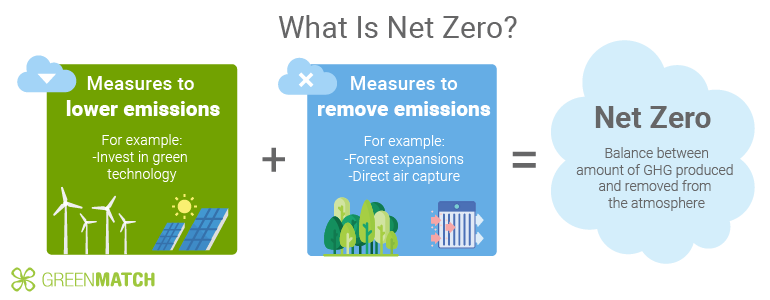- GreenMatch
- Blog
- Renewable Path to Net Zero Emissions
A Renewable Path to Net Zero Emissions (New Study)

What Is Net Zero?
The term that has been doing the rounds globally is ‘net zero’. But what exactly is net zero?
Net zero refers to the balance between the Greenhouse Gases (GHG) emissions produced vs taken out from the atmosphere. The concept of net zero can be achieved when the amount of CO2 produced is no greater than the amount removed. The idea is to reduce the amount of human caused emissions to as low as possible, and remove CO2 emissions from the atmosphere with initiatives such as reforestation or direct carbon removal.

With the rise of global warming, the world has been witnessing the need to combat climate change and Net zero is the way to go. Taking steps like switching to solar panels as a way of electricity generation can have a big impact on the environment. Changes have to be made both on a domestic and industrial level, in order to make it feasible for achieving this target over the next few decades.
According to the World Meteorological Organisation, the world has had the warmest 20 years within the last 22 years. Global temperatures are predicted to increase up to 5°C higher by 2100, which is alarming.
One of the contributors to climate change is GHG, and the need to strike the right balance and achieve net zero emissions is more important than ever.
- UK’s greenhouse gas emissions (GHG) fell by 40% over the last three decades, and need to fall by a 100% in order to achieve net zero.
- UK public awareness has increased in the last year. 66% of the UK public is aware about the concept of Net Zero and 82% of people are concerned about climate change.
- 80% of people support renewable energy and think it will help in achieving net zero.
- Half of the UKs electricity generation in 2019 was from low carbon technologies including renewables and nuclear.
- In 2019, the UK became the first big economy to pass laws to achieve Net Zero by 2050.
- Heating of both domestic and non-domestic buildings were responsible for 23% of UK GHG emissions in 2016.
- There are about 240,000 operational heat pumps in the UK, which holds a relatively low share in heating technologies.
- Air source heat pumps hold the majority heat pump market share of 87%.
- During November 2020, the UK recorded the highest number of monthly installations of solar PV (over 4000), since the close of FITs to new applicants.
Why Is Net Zero Emissions So Important to the UK?
The Committee on Climate Change (CCC), a public body that advises the government on climate change, has recommended that the UK must aim to achieve net zero Emissions by 2050. In order to comply with the Paris Agreement goal of limiting global warming to 1.5 degrees celsius, countries globally must aim to achieve net zero emissions.
Achieving net zero is important to the UK in order to be compliant with the Paris Agreement and also because of being the president of the next UN climate talks, the UK finds itself in a position to influence other countries.
The UK government, on 20 April 2021, announced that it will set an ambitious climate change target into law, in order to reduce emissions by 78% by 2035.
According to a survey by the Heat Pump Association, it is anticipated that the surge of low carbon heating technologies, like heat pumps, will almost double in 2021. This forecast is closely aligned with UKs Net Zero target.
According to CCC, the UK’s GHG emissions fell by 40% in the previous three decades, and in order to achieve net zero they must fall a further 100% in the next three decades.
In the chart below you can see how an overview of how the greenhouse gas emissions have been falling over the last three decades.
Mass of air emissions in thousand tonnes of CO2 equivalent.
The UK is currently not on track to achieve this and CCC has made recommendations on how it can achieve net zero emissions through various strategies across different sectors.
In this analysis, we will focus on the role of renewable energy in achieving net zero emissions, specifically the usage of domestic renewable energy and low carbon heating solutions.
Which Sectors Contribute to GHG Emissions?
The UK is more open for low carbon investment than ever before, and this shows that it is still technically possible to achieve net zero — though extremely challenging.
Various sectors contribute to GHG emissions and the strategies the UK is taking towards them will affect them in different ways, some more severe than others.
The chart below displays the contribution of GHG emissions from different sources such as energy supply, residential and more, over the last three decades.
Million tonnes carbon dioxide equivalent.
In the times of COVID-19, the UK government is coming up with initiatives such as the Green Homes Grant, to encourage low carbon investment on a grassroot level with grants for heat pumps and windows grants.
Future GHG emissions reduction will require people all over the UK to contribute in ways they can by making low carbon choices, such as the way they travel, the way they heat their homes, the electricity consumption methods, and the sustainable lifestyle choices they make.
This brings us to the point of understanding the general public attitudes towards climate change, net zero and their willingness to contribute to the greater cause.

Understanding Public Attitudes in the UK Towards Net Zero
Every quarter, The UK government runs a survey to track public attitudes on a variety of subjects. The data collected can be used to understand the shifts in attitudes based on seasonal changes, on crucial topics. In the latest report from November 2020, the public was surveyed on a range of topics including climate change, renewable energy and net zero. Listed below are the key findings from the survey:
- Measures across different periods in 2020, the awareness towards net zero has increased in the people of the UK. 66% of the public is aware of the concept of net zero.
- 82% of the people are moderately to severely concerned about climate change, which also slightly increased towards the end of 2020.
- Does the public think transitioning to renewable energy will help in achieving net zero? Around 80% of the people support renewable energy and only 3% oppose it. Solar energy was supported by 85% of the people, which is the highest among other renewable energy sources like tidal, wind, and biomass.
How Does Renewable Energy Contribute to Net Zero?
According to CCC, half of the UK’s electricity generation in 2019 was from low carbon technologies including renewables and nuclear. But, in order to achieve net zero by 2050, the UK will need to quadruple its low carbon electricity generation.
Lately, the UK has been encouraging the usage of renewable technologies like solar and heat pumps by introducing various grants and rebates. The cost of solar has reduced significantly over the last decade and heat pumps are more affordable with the availability of grants.
In the chart below you can see the increase in energy use from renewable and waste sources including solar photovoltaic, biomass, hydroelectric and other sources, on UK resident basis.
Gross calorific values, million tonnes of oil equivalent.
In June of 2019, the UK became the first big economy to pass laws to achieve net zero by 2050. This means that the country must decarbonise across different sectors and cut emissions further in the power sector. Clean power generation needs to grow faster than ever to meet its electricity demands, as well as become more cost-effective over the years.
To reach the set targets of net zero, renewable electricity generation plays an important role. The government must aim to create a market that promotes renewable and low carbon technology deployment by providing potential benefits for doing so.
In the chart below you can see the energy usage from renewable sources to generate heat including active solar heating, heat pumps and geothermal aquifers, on UK resident basis. We can see that heat pumps have been taking off since 2008, but the data regarding heat pumps were available only until 2017.
Gross calorific values, million tonnes of oil equivalent.
Growing Popularity of Renewable and Low Carbon Technologies in UK
Low carbon electricity can be produced much more cheaply now in the UK and around the world. It is becoming a dominant energy sector for the UK with output increasing rapidly over the years.
Domestic renewable technologies have also been growing in popularity as people are transitioning to self-sufficient sustainable energy sources. Low carbon heating is also gaining popularity in the UK. GHG emissions associated with domestic and non-domestic buildings were responsible for 23% of UK emissions in the year 2016. The UK is emphasizing on low carbon investment as one of the ways to achieve net zero.
The goal of net zero emissions aims to decarbonise electricity by 2030, which focuses on meeting the rising demand with low carbon generation.
The following two technologies help in heat and electricity generation and eventually contribute to net zero on a domestic scale:
Solar Panels
According to the Sixth Carbon Budget recommendation, solar generation should increase from 10 TWh in 2019 to 60 TWh in 2035 and 85 TWh in 2050. The costs of solar panel installations have been going down over the years, making it a more feasible solution for generating electricity.
During November 2020, the highest monthly installations (over 4000) of solar PV were registered since the closure of the Feed in Tariffs to new applicants. The number of installations saw a huge drop in April 2020 due to COVID-19, though they have again picked up to pre-lockdown levels after July 2020.
The chart below shows Solar PV deployment by its cumulative capacity. We have only taken domestic solar panels that are also eligible for the Smart Export Guarantee.
Solar PV cumulative capacity (MW).
Solar panels are very efficient and can increase the value of your property, especially with their growing popularity of being a renewable source of energy—which is why they are a great green home improvement idea.
You can check out more green home improvement ideas that can increase your property value and reduce your energy bills.
The UK government is also encouraging its people through solar panels funding opportunities such as the Smart Export Guarantee (SEG), where homeowners who have installed photovoltaic systems can earn money by exporting surplus energy back to the grid. SEG is a grant that has effectively replaced the Feed-in Tariff, and has been in effect since January 2020.
Heat Pumps
According to Government data, GHG emissions in the UK that are associated with heating both domestic and non-domestic buildings were responsible for 23% of emissions in 2016.
This is a big number and if net zero needs to be achieved by 2050, then decarbonising the heating sector plays an important role. An important step to take towards this is to understand the potential growth of heat pumps in the UK as a low carbon heating solution.
Currently, the deployment of heat pumps in the UK is relatively small with a total of approximately 240,000 operational heat pumps in total.
This figure represents less than 1% of heating systems when compared to fossil fuel boilers, which hold the majority share in the market.
Air source heat pumps hold a massive 87% of heat pump market share, as they’re a great option for both newly built homes and as retrofits. Ground and water source heat pumps combined only hold 9% share of the market.
The chart below displays the annual amount of heat pumps that are currently operational in the UK.
Heat pumps are primarily classified by the source of generating heat, that is either through ground or air.
Ground source heat pumps (GSHPs) distribute heat using underground pipes heated up by ground heat, which then feed the heat to the house’s wet central heating system, such as radiators, showers, faucets, or underfloor heating.
Air source heat pumps (ASHPs), on the other hand, use the outside air to heat your home. Air to water heat pumps extract heat from the air outside, compress it, and release it through radiators, underfloor heating, and hot water circuits. Air to air heat pumps use a similar principle, though are only used for space heating by blowing compressed hot air through an indoor unit.
The UK government has been laying a lot of focus on increasing heat pump deployment by encouraging providers and homeowners to take advantage of this low carbon heating solution through grants such as the Renewable Heat Incentive (RHI), and the new Green Homes Grant, launched in 2020.
Under the RHI, people installing heat pumps may be eligible for receiving payments for each kWh of energy generated over a seven-year period.
The new Green Homes Grant is a new scheme implemented during the COVID-19 pandemic and incentivises homeowners to install low carbon heating solutions by covering two-thirds of the installation costs for homeowners and landlords in England.

Impact of COVID-19 in Achieving Net Zero
There is no doubt that COVID-19 has had a profound impact on the UK economy. Though the long-term effects are still undetermined.
The UK aims to bounce back to pre-crisis level by as early as 2022 in an optimistic scenario. Achieving net zero is integral to recovering from the COVID-19 crisis, says the Government.
The UK is taking steps to invest and create opportunities in a sustainable economy that are aligned with achieving net zero. In fact, net zero aligned investments should be a key objective while dealing with COVID-19 recovery.
In the post COVID-19 era, decarbonising the UK across various sectors will help in the path of achieving the balance to net zero emissions.
Is Reaching Net Zero by 2050 Feasible for the UK?
The CCC believes that, even though highly challenging, net zero is possible by 2050.
Based on recommendations for the Sixth Carbon Budget, the CCC has described a path towards achieving net zero and a decarbonised UK. A key challenge for net zero is to scale up such that all new investments are zero carbon by 2030s.
Deep decarbonisation on a domestic level to nearly zero residual emissions is still possible. According to the CCC, the Further Ambition scenario, which was presented in the Net Zero report, abates 95% of direct emissions from the existing builds at an annual cost of £13 billion. This scenario supports the growth of renewable and low carbon technologies. It is expected to include 20 million individual and hybrid heat pumps.
All in all, the UK government has recognised the need for policy strengthening in all areas of UK emissions, in order to achieve net zero by 2050.
Research Methodology
This article is an analysis of different sets of data published over the last months. We aim to educate the public on how net zero emissions can be influenced even on a domestic scale. The post will be updated as and when we find news that adds value in order to update our readers.
The following sources were used to compile this study:

Valli has been writing well researched articles about renewable energy, sustainability and green technologies for GreenMatch since 2017. Her work has been published in various media such as Entrepreneur, Business Insider, Canadian Geographic, uSwitch, and eCycle.
We strive to connect our customers with the right product and supplier. Would you like to be part of GreenMatch?




